. . . salute you! Pluckiness and faithfulness never go out of style!
Monthly Archives: December 2009
PARIS: DOUBLE VISION — THE ALCHEMY OF THE GRAND VÉFOUR, PART ONE
The stage has been set, the backstage machinery inspected — now the curtain rises on the show, with its sometimes spectacular, sometimes subtle transfer of magic. Coralie Chappat shares a meal with us at the Grand Véfour restaurant in Paris:
Je prends place dans l’écrin au rouge velours du Grand Véfour, dans sa
salle dont je ne puis dire si elle est grande ou petite tellement elle
est magique où s’anime dans une appréciable discrétion, le personnel
que je vois sans voir. Je m’étoffe de l’intimité du lieu. Mes points
de repères s’évanouissent, une sortie du champ a congédié toute
extériorité jusqu’à l’existence même du temps. Je suis portée au gré
d’une sensualité inspirante. J’éprouve vivement la réceptivité de mes
cinq sens, dans une proximité surprenante.
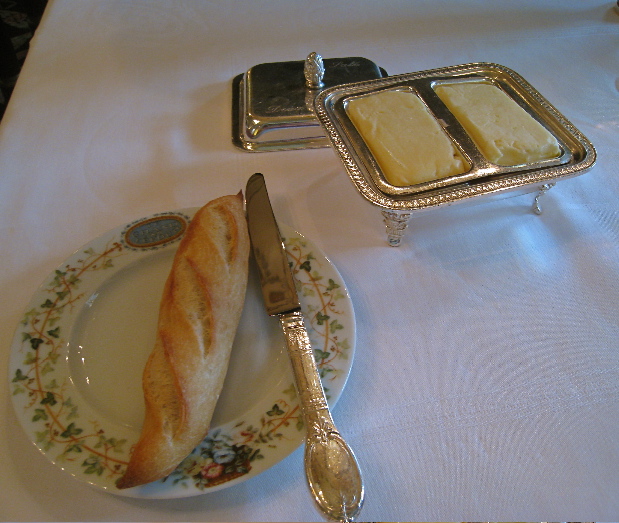
La plus simple des nourritures se revêt de charme élitaire lorsque la
facture des couverts d’argent rencontre la porcelaine délicate.
La sobriété de l’expression est semblable à l’esthétique de la litote
car lorsqu’elle en dit le moins, elle fait entendre le plus. Je suis
plongée dans l’immédiateté du lien qui unit le plaisir au désir.
Les matières se frôlent, se marient, se séparent sans trouble aucun,
tandis que les couleurs se magnifient par leur rapprochement.
WINTERLUDE
[Image by Weegee]
Christmas Day may be over but the Twelve Days Of Christmas continue! We've got a lot more celebrating to do, folks — rest up, grab a nap when and where you can, and get ready for the merriment still to come!
A EULOGY FOR EBENEZER SCROOGE
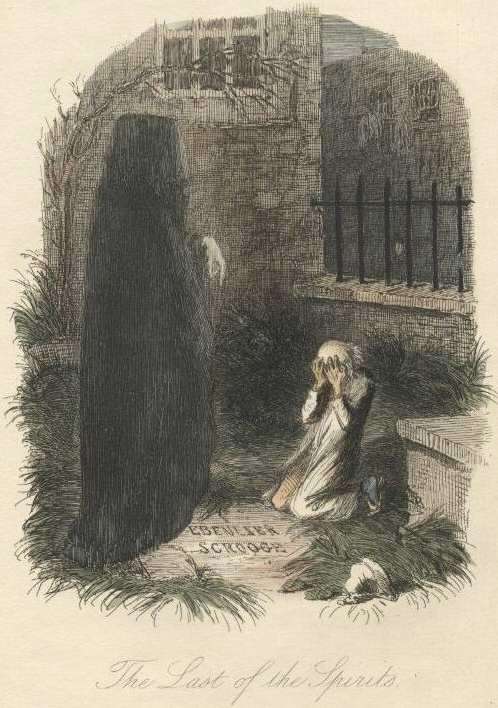
It's been well over a hundred years since Ebenezer Scrooge died. No one who knew him is alive today, of course, but he is remembered — not least from this eulogy spoken at his funeral:
This week, we have lost one of our town's finest citizens. Ebenezer Scrooge passed away five days ago, on Boxing Day, at the age of 82. At his death, he was surrounded by his loving nephew Fred, Fred’s wife, and their three children. His faithful house servant, Mrs. Dilber, who nursed him in the last weeks of his life, described him as peaceful and comfortable, and dressed in his best, surrounded by family, and the beautiful bed curtains that she, and the other house servants, made him.
Many of you will remember Scrooge as a brilliant businessman. His company, Scrooge and Cratchit, gave many jobs in his warehouse to the unemployed throughout the city. He and his business partener Bob Cratchit helped many young men start up their own businesses, too.
Others of you may remember Scrooge for his good works. As the director of many of his charities, such as the Christmas Fund, the Hospital for the Poor, and his Soup Kitchen for the Hungry, I can tell you the good this man has done.
His orphanages have been a refuge for many abandoned children. And his Houses of Learning, which teach my own son and daughters, and which I attended as a young lad, have earned fine reputations.
Some of you may even be old enough to clearly remember Ebenezer Scrooge in the years before his miraculous transformation. Some say he was mean spirited, stingy, and liked it. No one knows exactly what changed him, for he never spoke of it. But many believe that it was the high spirits of Christmas.
For me, I remember Ebenezer in a different way. For he saved me. In a way, we were both crippled when we first met. I physically, and he emotionally and spiritually. If it weren’t for Scrooge, I wouldn’t have met my lovely wife, Edith. If it weren’t for Scrooge, I wouldn’t have had my dear children. If it weren’t for Scrooge, I would have died sick, as a tiny young boy. Because of Scrooge, I haven’t even touched my little crutch in nearly twenty years.
I owe Scrooge my life, and I am forever grateful to him. I think that we can all remember Scrooge not for who he was, but for who he became. And we can all honor his memory, by celebrating his life on Christmas, his favorite holiday. Thank you.
[Transcribed by my niece, Nora Rossi, from an old parish register in London]
LE SPECTACLE! LE SPECTACLE!
One of my favorite things to do in Paris is hunt down the traditional children’s puppet shows put on in parks. Sometimes they are done out of doors with portable stages, but the more venerable ones have little enclosed theaters of their own.
The shows date from the 18th Century, when a French dentist, Laurent Mourget, adapted a character from the Commedia dell’Arte — Polichinelle, called Punch in England — and cast him as the rambunctious star of short puppet shows, which he used to attract clients. (He pulled teeth for free and made his money selling painkillers after the procedure.) Eventually Polichinelle morphed into Guignol, a poor tradesman with great wit and a strong sense of justice, who was constantly getting the better of those he tangled with.
The shows proved more popular than his dental practice, so Laurent devoted himself to them, and they spread to all parts of France. Many of the Guignol companies that survive today can trace their decent back to the dentist and his children, who carried on their father’s work.
Kids still adore them. One of my favorite memories of Paris is a little group of children waiting for an outdoor Guignol performance in a tiny park. They could barely contain their excitement and suddenly began chanting, in high, piping voices, “Le spectacle! Le spectacle!” It’s how we all feel, waiting for a show to start.
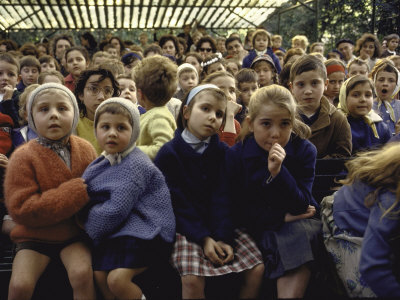
[Photo © Alfred Eisenstadt]
Today, as a special treat for Christmas Eve, Coralie Chappat takes mardecortesbaja readers to a Guignol performance in the Champs de Mars, Paris — revisiting le spectacle for the first time since she was a little girl:
Je n’ai pas revu le petit théâtre de marionnettes depuis mes 6 ou 7 ans. De l’extérieur il me semble intact malgré toutes ces années où je l’ai ignoré. Après avoir passé le guichet de l’entrée, je suis troublée par ce qui se produit en moi. Je ne suis qu’une émotion
d’euphorie ; rien de plus, et rien de moins.
M’asseyant sur un des bancs, face à la scène, je reconnais au sommet du rideau, l’effigie de Guignol, le héros de ma petite enfance. Il n’a pas changé. Moi, non plus. J’ai le sentiment que nous ne nous sommes jamais quittés.
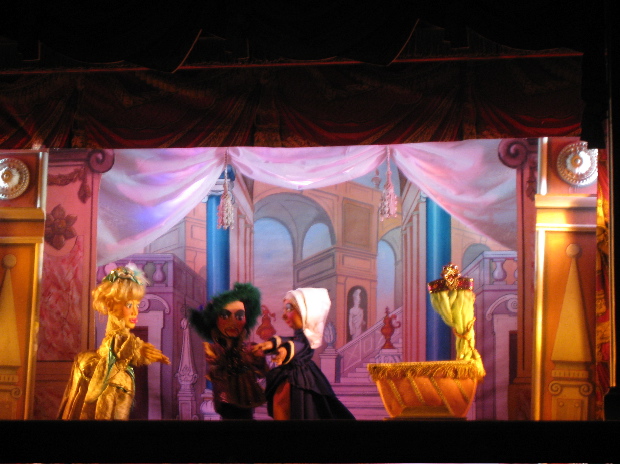
Aujourd’hui se joue “La belle au bois dormant”. Le théâtre a déployé son espace esthétique autonome à la manière d’une petite arche de Noé, embrassant seulement ses passagers. J’attends avec impatience, l’entrée de Guignol sur scène. En choeur nous l’implorons, tandis que le château s’est endormi.
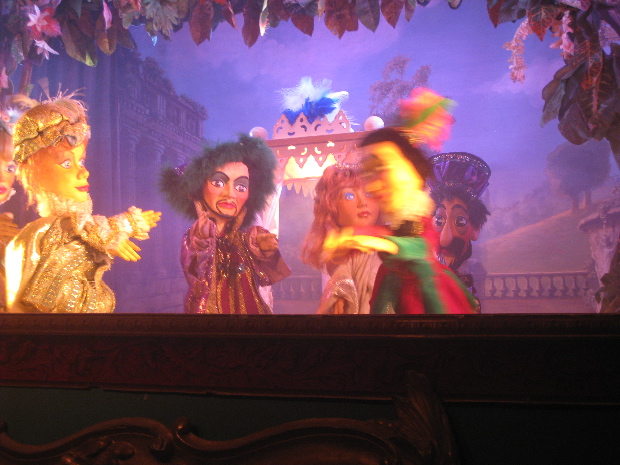
Enfin, Guignol est celui qui conduit le prince au chevet de la Belle. Je suis éblouie par sa présence. Il dégage une noble prestance. Son visage rayonne d’intelligence, de courage et de beauté. Son bel uniforme fait valoir son aristocratie.
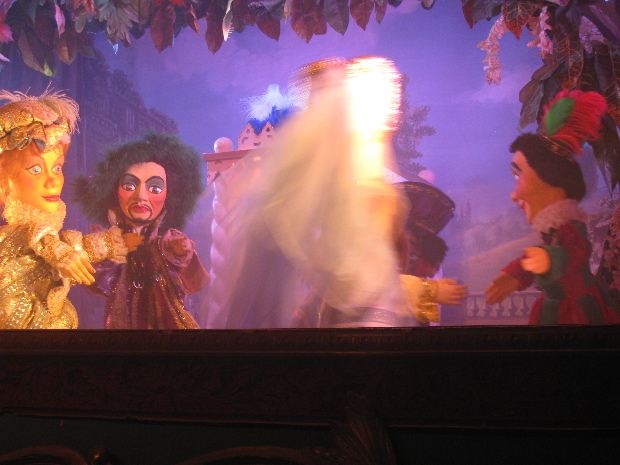
Lorsque le rideau tombe, je reste paisible . . .
Guignol de son immortalité, a fait fi du temps.
[Photos © 2009 Coralie Chappat, except where noted]
O LITTLE TOWN OF BETHLEHEM — IN THE HEART
Have you ever wondered what Bethlehem looked like at the time Jesus was born
there? It wasn’t something Pieter Bruegel the Elder wondered about —
he knew it looked just like any small town in the Netherlands, where he
lived, and that winter there was pretty much the same as the winters he grew up with.
So in 1566 he painted The Census At Bethlehem,
above, from life, as it were, simply inserting Mary and Joseph and
their donkey into the scene. As you can see, the inn looks pretty
crowded — have Mary and Joseph waited too late to arrange for
accommodation? Mary is about to give birth — suppose Joseph can’t
find her a room?
Well, thereby hangs a tale . . .
Dylan closes his very strange Christmas album with this song about Bethlehem, and closes the song itself with a quiet, heartfelt “Amen”. Bethlehem is no stranger to Dylan than it was to Pieter Bruegel — he sings about it as though it’s as real and familiar as that little whistle-stop up the road, where the only motel in town is tiny and the diner closes at nine.
Why does Dylan feel so at home there, just as much at home as Pieter Breugel once did? It’s a mystery which the art itself has no obligation to resolve.
Much has been made of this exchange from an interview Dylan gave to Bill Flannagan of the Street Newspaper:
BF: You really give a heroic performance of “O’ Little Town Of Bethlehem”. The way you do it reminds me a little of an Irish rebel song. There’s something almost defiant in the way you sing, “The hopes and fears of all the years are met in thee tonight.” I don’t want to put you on the
spot, but you sure deliver that song like a true believer.
BD: Well, I am a true believer.
Dylan watchers will know enough to catch the ambiguity of the response. “A true believer in what?” we might ask. As far as I’m concerned, Dylan’s personal religious beliefs are entirely irrelevant to Christmas In the Heart. Nothing he might say or not say about them can change a note of what’s on the record, and nothing on the record can constitute reliable evidence about what he “really believes” — anymore than Jan Van Eyck’s Altarpiece of Ghent can tell us anything definitive about Jan’s personal religious beliefs.
What we can say is that Dylan sings “O’ Little Town Of Bethlehem” in the voice of a true believer, that the performance is incredibly moving, whether considered as a work of art or as a witness of faith. The way he hits the word “dear” in the phrase “the dear Christ enters in”, the solemn humility and peacefulness of that final “Amen” . . . these are things to marvel at, things that touch the heart.
As with Van Eyck’s altarpiece, Dylan has brought a lifetime of craft to this work, an extraordinary commitment of feeling and care, without a trace of cowardly, modernist irony. It is deeply “religious” art, in subject and execution, art that transcends the personality of the artist . . . the sort of art we don’t see much of these days, and a wonderful reminder of what we’ve been missing.
Art like this doesn’t ask (much less answer) the question “What does the artist really believe?” It asks the question “What do you really believe?”
The sarcastic scorn being heaped upon Christmas In the Heart in some quarters, with knowing, cowardly, modernist irony, tells us all we need to know about the sorry state of our culture in this troubled holiday season of 2009. Dylan’s album tells us that things could be different, should be different.
Can I get an “Amen”?
Back to the Christmas In the Heart track list page.
THE CHRISTMAS SONG — IN THE HEART
Bob Dylan’s Christmas In the Heart, track by track . . .
Dylan just eases into this one, with a quiet pleasure that summons up an image of him settling back in an armchair before the fire, wearing his Bing Crosby cardigan and filling up a pipe — with tobacco! The ghost of his favorite dog from childhood, old Shep, is curled up at his feet, he can smell the turkey roasting in the oven and he knows that the egg nog in the icebox is just about ripened. Boy, that’s gonna be good.
The night wind is whipping snow against the windowpanes, and Bob is entertaining visitors, even though nobody but him can see them.
He’s communing here, with Bing and Nat and Frank, not trying to outdo them, just happy to be in their company.
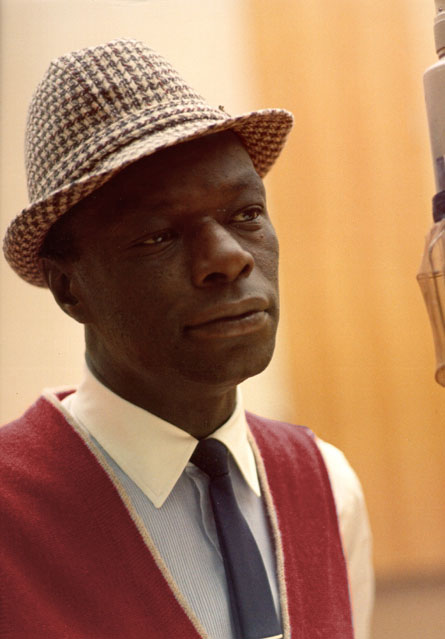
In short, he’s messing with your head. He’s messing with his own head. But what the heck? Just throw another log on the fire, settle back in your own armchair and enjoy it. It’s Christmas . . . the happiest season of all.
Back to the Christmas In the Heart track list page.
CHRISTMAS ISLAND — IN THE HEART

Bob Dylan’s Christmas In the Heart, track by track . . .
How’d you like to spend Christmas on Christmas Island? Dylan and his devilishly cute-sounding girl back-up singers make it seem like a swell idea.
In an interview about the album, Dylan said he knew nothing about Christmas Island — not even if it was a real place. It is — that’s a picture of it above. It’s the largest coral island in the world, sits in the middle of the Pacific Ocean and was discovered in 1777 by Captain Cook — on Christmas Eve, natch. It was unpopulated then but now has a few thousand inhabitants and, due to its position relative to an international date line, is the first inhabited place on the globe to ring in the New Year.
The British conducted some of their first nuclear bomb tests there in the late Fifties and early Sixties — radio reports of which may have entered Dylan’s subconscious at the time. Graham Greene mentioned the tests in his novel Our Man In Havana, clearly struck by the irony of such things happening on an island so named.
The song was first recorded by the Andrews Sisters (above) in 1946, reflecting America’s fascination with the Pacific islands in the post-WWII era. After the horrors which unfolded on them in that war, they took on a paradoxical aura of magic, making Hawaiian shirts, exotic tropical drinks and “Tiki” music irresistible. Were they the symbol of an innocent paradise lost in the war, which we wanted to recover? Or did we simply feel a new, proprietary affection for the places where so much American blood was spilled?
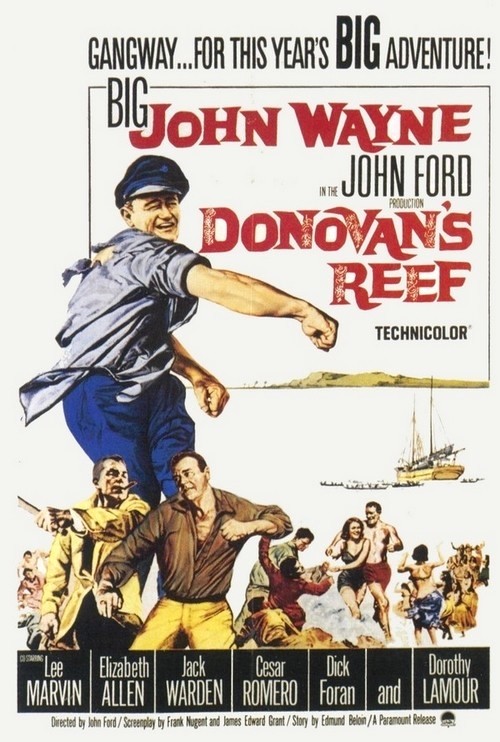
All the contradictions were embodied in works like South Pacific, the stage and film musical, and in John Ford’s Donovan’s Reef (where a South Seas Christmas celebration figured prominently in the tale.) Both these works explored the subject of racism, in a setting where the issue was perhaps easier to engage, metaphorically, than on home soil. (Thanks to Paul Zahl for noting the Donovan’s Reef connection.)
Musically, the Tiki style, with its pedal-steel guitar, influenced country-western music (and, as Mary Zahl has reminded me, Dylan’s own Tiki-inflected pastiche, “Beyond the Horizon”). Bing Crosby and Jimmy Buffett, both of whom Dylan admires, recorded covers of “Christmas Island”.

So a lot of cultural lines intersect in this song, as they do in all the songs on Christmas In the Heart, but the best thing about Dylan’s version is that he plays it straight, without “quotes” around the number — it’s not about nostalgia or irony or attitude. It gets to the heart of what made the Tiki style so appealing — a dreamy, lyrical vision of places where love and life are easy, simple, natural . . . places where goodness calmly gets the better of meanness . . . places where all your Christmas dreams come true.
Back to the Christmas In the Heart track list page.
THE FIRST NOËL — IN THE HEART
[Image © 2007 Midolluin]
Bob Dylan’s Christmas In the Heart, track by track . . .
As I wrote recently to a friend, Dylan has a capacity to re-imagine Christmas as though the past 2000 years of institutional church nonsense never happened. He seems to be singing from the apostolic era of Christianity, as an eyewitness to what went down back then.
On this song, I have no trouble hearing the voice of one of the original shepherds in Bethlehem who first saw the momentous star and followed it to a stable, where a baby was being born. The shepherd was a boy then — now he’s an old man, but he’s telling the story one more time, just as he remembers it. “And by the light of that same star,” Dylan sings, in a tone that suggests he’s saying, “. . . that star, boys, the one I was telling you about, the one I saw.”
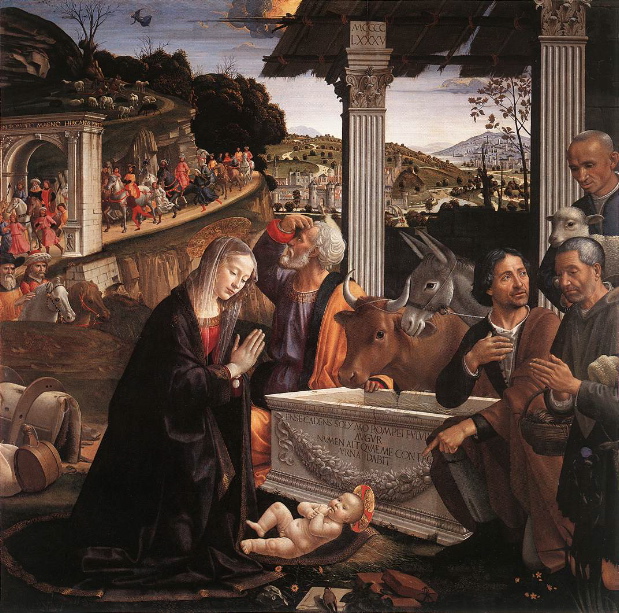
And as he’s telling it, he gets caught up in the excitement of it . . . one more time — not just reporting anymore, by the end of the account, but adding his voice to the angels’ chorus, quite carried away by the word they kept repeating . . . “Noël!”
He’s probably dined out on the story more times than he cares to remember, to the point where the old-timers of Bethlehem are sick of it, but it still gets to him, in spite of himself. It makes him feel like a kid again.
Back to the Christmas In the Heart track list page.
SILVER BELLS — IN THE HEART
Bob Dylan’s Christmas In the Heart, track by track . . .
Dylan’s version of “Silver Bells” has a country-tinged arrangement, which subtly suggests that the singer is far from home this holiday season, looking around in wonder at the city celebrations, “Santa’s big scene”. Dylan delivers the lyrics with a quiet sort of reverence, though — as he listens for the transcendent meaning of it all, which he hears in the silver bells ringing out from the steeples of churches, high above the bustle, echoed perhaps in the hand-bells of the sidewalk Santas.
You’re bound to think of the vision delivered in Dylan’s own song “Ring Them Bells”, in which sacred bells toll out their timeless commentary on “the wheel and the plow”.
In the middle of the urban hurly-burly, Dylan is looking for something that isn’t immediately apparent, something that speaks only to the heart.
Back to the Christmas In the Heart track list page.
MUST BE SANTA — IN THE HEART
Bob Dylan’s Christmas In the Heart, track by track . . .
The raucous arrangement here is led by David Hidalgo, of Los Lobos, on accordion. His Tex-Mex style comes full circle, back to the polkas played in south-Texas German communities which morphed into the Latin-inflected border music of today.
It’s all part of the delirious free-fall through American music that Dylan takes on Christmas In the Heart, into a place where there are no borders between styles, genres, periods. No borders, either, between high-brow and low-brow taste, deeply religious and secularized Christmas music, fun and faith. In short, this is a journey into culture as it’s actually experienced, a jumble of modes and moods and images that somehow adds up to Christmas in America. Dylan is down on his knees at one moment, up on his feet dancing at another. This is not chaos — it’s life.
He’s dancing on this song, proving that joy to the world doesn’t have to be delivered on an organ in a church, or in a choirboy’s voice. Further commentary would be useless — you need to get up off the couch and dance to this one.
As the wacky video of the song suggests, it’s one way of shooing the Devil and all his works out the window.
Back to the Christmas In the Heart track list page.
PARIS: DOUBLE VISION — THE GRAND VÉFOUR UNDERGROUND, PART TWO
Today, Coralie Chappat takes mardecortesbaja readers into the heart of the Grand Véfour restaurant in Paris — the underground kitchen. It looks so spotless it’s hard to imagine that food is actually prepared in these spaces, but it is, as future reports will affirm. Note, too, the reference photos posted above the work counters, ensuring that the presentation of the dishes will conform to the chef’s original conceptions. Coralie writes:
Les lourds plafonds bas et l’espace réduit se déploient en trois
souterrains donnant à l’ensemble, l’esthétique du sous-marin. Les
lieux pour lesquels l’absence d’effluves me surprend, me sont décrits
avec la précision requise: la chambre froide:
. . . le couloir des desserts:
. . . le coin des mets chauds:
À chaque espace est assignée une tâche singulière, mais je ne retiens qu’un ensemble de carrelages et de plans de travail en acier inoxydable, qui font effet de négatif photo aux images culinaires du Grand Véfour. Mon regard lisse les surfaces, parcourt les renfoncements, s’incruste dans les moindres recoins, pendant que mon enthousiasme se mue en une interrogation nimbée de mystère. J’en imagine le fonctionnement pareil à un mécanisme d’horlogerie.
Aucun indice, pas la moindre évidence ou trace sur la manière dont ces
petits miracles s’accomplissent. Une sensation s’éprouve néanmoins.
De ce laboratoire au laborieux quotidien où la fonction se lit beauté,
se dégagent des inclinaisons altruistes inspirant le respect.
Arrivée au terme du temps qui m’est imparti ; il n’y a pas l’ombre d’un
doute. C’est bien de magie qu’il s’agit.
[Photos © 2009 Coralie Chappat]
HAVE YOURSELF A MERRY LITTLE CHRISTMAS — IN THE HEART
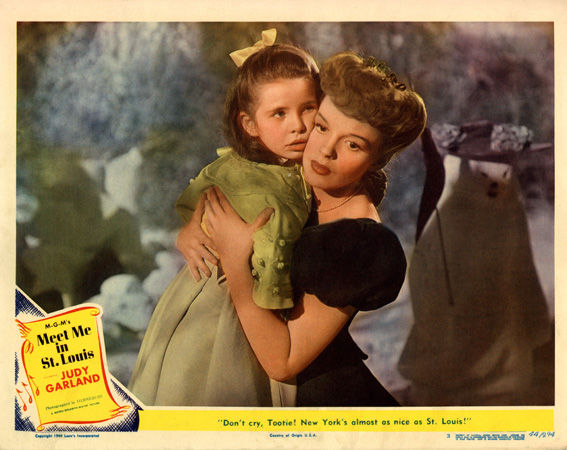
Bob Dylan’s Christmas In the Heart, track by track . . .
Finally Dylan comes up against a song with a precedent he can’t really improve upon or add much to. Judy Garland’s recording of “Have Yourself A Merry Little Christmas”, done for the soundtrack of Meet Me In St. Louis, is the definitive version of the song, treading the line between the lyric’s sadness and its hopefulness with sublime delicacy.
It’s only her soundtrack version that rules, though — the recording she made for the song’s commercial release on Decca is very fine but not quite as moving. This was true of many of her movie songs, which she really “acted” on the MGM recording stage, then performed in a more neutral style for Decca.
Dylan’s version is very fine, too. He sings it tenderly — but somehow he misses the melancholy, half-panicked undertow of Garland’s soundtrack recording. Only on the line “until then we’ll have to muddle through somehow” does he suggest that things might be worse than he’s letting on elsewhere in the song.
[Image © 2009 Drew Friedman]
Sinatra, on his similarly fine recording, also misses the full measure of melancholy that Garland conveys — though like Dylan he has his moments. When he sings “so have yourself a merry little Christmas now” you can feel a sense of doubt and resignation that gets to the song’s core.
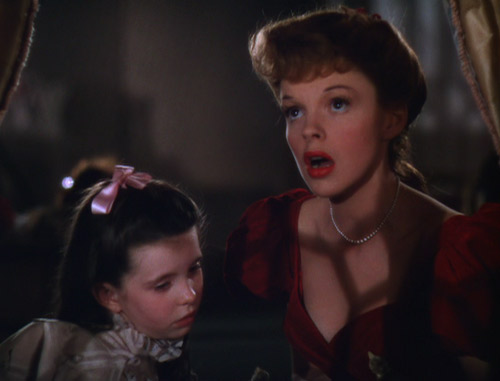
Garland is aided greatly on the soundtrack recording by Conrad Salinger’s subtle but deeply expressive arrangement, which brilliantly evokes the melancholy mode without hitting you over the head with it. This allows Garland her own subtlety in interpreting the song — you feel its sadness without quite being conscious of it, at least on a first hearing. On subsequent hearings you realize that Garland’s character in the film is not just trying to reassure her younger sister with the sweet song, she’s trying to reassure herself — and not quite succeeding.
Garland’s is one of the greatest vocal performances of all time — to say that Sinatra and Dylan almost give her a run for her money is high enough praise for any singer.
Back to the Christmas In the Heart track list page.
PARIS: DOUBLE VISION — THE GRAND VÉFOUR UNDERGROUND, PART ONE
The venerable Grand Véfour restaurant in Paris is located in a colonnade at the edge of the Palais Royal garden, above. The entrance, below, opens onto a magical space for dining, but below this space is the heart of the Grand Véfour — penetrated by Coralie Chappat on a recent visit. Here is the first part of her report on her adventures underground:
Si les kamis sont les divinités ou esprits qui s'attachent au Japon,
aux objets autant qu'aux lieux sacrés, et que les elfes habitent les
lieux souterrains ; ces touchantes créatures devraient bien être
perceptibles d'une quelconque façon? Aussi je pensais qu'en visitant
l'antre du Grand Véfour, la magie se livrerait à moi et que je
comprendrais dès lors comment ces petits miracles qui conquièrent tous
nos sens, surgissent comme par enchantement, ne pouvant relever que de
la seule dextérité humaine. Après m'être ennoblie des mets les plus
fascinants, j'obtiens par faveur la visite des lieux sacrés.
Je déguste un caramel mou et une dernière mignardise, lorsque le maître
d'hôtel me conduit par le petit escalier rond qui s'enfonce sous
terre. Plus je descends, plus je pénètre l'épaisseur du secret.
Next . . . the mysteries of the kitchen revealed!
O, COME, ALL YE FAITHFUL (ADESTE FIDELES) — IN THE HEART
Bob Dylan’s Christmas In the Heart, track by track . . .
Now we come to another of the classic carols on the album, which, as I’ve written before, “have a different kind of joy than the upbeat pop numbers —
almost triumphal. Dylan sings the first verse of ‘Adeste Fideles’ in
Latin, punching out the words like a preacher on fire with the
unimpeachable authority of the good news he’s delivering. Now that
Pavarotti has moved on, is there anybody left but Bob who can sing
Latin like he means it?”
Pavarotti, by the way, does a stunning version of this song on his great Christmas album O Holy Night. There, Pavarotti summons the world to worship, in tones meant to ring out from one end of the globe to the other. Dylan, by contrast, seems to be addressing a small band of stragglers at the back of beyond. He sings the name of Christ as though you might not have heard it before, stretching it out into two syllables (verging on three.) He doesn’t sing “O come let us adore him” as it’s ever been sung before — the “O” is more of a cross between “Aww” and “Ahh”, as though his own heart were being pierced by the exhortation.
The stragglers are not alone, however — Dylan’s back-up girl group chimes in sweetly at the end, addressing “all ye citizens of Heaven above” . . . the seraphim and cherubim who are accompanying the rag-tag pilgrims on their impromptu journey to a little stable somewhere.
Dylan’s version of “Adeste Fideles” is the greatest version of this song that ever has been, and probably ever will be, done.
Back to the Christmas In the Heart track list page.
